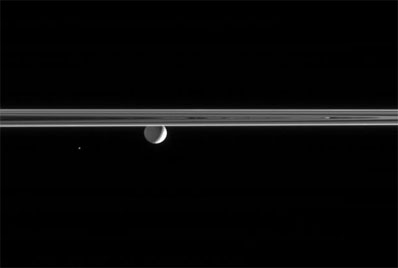
Spaceflight Now +

|

|

|

|

Premium video content for our Spaceflight Now Plus subscribers.

Message from Apollo 8
 On Christmas Eve in 1968, a live television broadcast from Apollo 8 offered this message of hope to the people of Earth. The famous transmission occurred as the astronauts orbited the Moon. On Christmas Eve in 1968, a live television broadcast from Apollo 8 offered this message of hope to the people of Earth. The famous transmission occurred as the astronauts orbited the Moon.

 Play video Play video

ISS receives supply ship
 The International Space Station receives its 20th Russian Progress cargo ship, bringing the outpost's two-man Expedition 12 crew a delivery of fresh food, clothes, equipment and special holiday gifts just in time for Christmas. The International Space Station receives its 20th Russian Progress cargo ship, bringing the outpost's two-man Expedition 12 crew a delivery of fresh food, clothes, equipment and special holiday gifts just in time for Christmas.

 Short | Full length Short | Full length

Rendezvous with ISS
 This movie features highlights of the December 23 rendezvous between the Russian Progress 20P vessel and the International Space Station. The footage comes from a camera mounted on the supply ship's nose. This movie features highlights of the December 23 rendezvous between the Russian Progress 20P vessel and the International Space Station. The footage comes from a camera mounted on the supply ship's nose.

 Play video Play video

Stardust return preview
 NASA's Stardust spacecraft encountered Comet Wild 2 two years ago, gathering samples of cometary dust for return to Earth. In this Dec. 21 news conference, mission officials and scientists detail the probe's homecoming and planned landing in Utah scheduled for January 15, 2006. NASA's Stardust spacecraft encountered Comet Wild 2 two years ago, gathering samples of cometary dust for return to Earth. In this Dec. 21 news conference, mission officials and scientists detail the probe's homecoming and planned landing in Utah scheduled for January 15, 2006.

 Dial-up | Broadband Dial-up | Broadband

Science of New Horizons
 The first robotic space mission to visit the distant planet Pluto and frozen objects in the Kuiper Belt is explained by the project's managers and scientists in this NASA news conference from the agency's Washington headquarters on Dec. 19. The first robotic space mission to visit the distant planet Pluto and frozen objects in the Kuiper Belt is explained by the project's managers and scientists in this NASA news conference from the agency's Washington headquarters on Dec. 19.

 Dial-up | Broadband Dial-up | Broadband

New views of icy moons
 NASA's Cassini spacecraft orbiting Saturn is wrapping up a phenomenally successful year of observing the mysterious icy moons, including Enceladus, Dione, Rhea, Hyperion and Iapetus. NASA's Cassini spacecraft orbiting Saturn is wrapping up a phenomenally successful year of observing the mysterious icy moons, including Enceladus, Dione, Rhea, Hyperion and Iapetus.

 Play video Play video

 Become a subscriber Become a subscriber
 More video More video

|

|

|

|
|

|

Small worlds orbiting Saturn
CASSINI PHOTO RELEASE
Posted: December 26, 2005

Credit: NASA/JPL/Space Science Institute
Download larger image version here
|
Gazing across the ringplane, the Cassini spacecraft spots a Saturn-lit Mimas and the tiny Trojan moon Helene. Only the bright crescent on Mimas' eastern limb is lit by the Sun; the moon's night side is illuminated by Saturnshine, or "greylight" as it is called by imaging scientists.
Helene (32 kilometers, or 20 miles across) shares the orbit of Dione (not pictured here) and is visible as a speck to the left of Mimas. This view shows the Saturn-facing side of Mimas (397 kilometers, or 247 miles across).
The image was taken in visible light with the Cassini spacecraft narrow-angle camera at a distance of approximately 2 million kilometers (1.2 million miles) from Mimas and at a Sun-Mimas-spacecraft, or phase, angle of 121 degrees. Helene was about 2.2 million kilometers (1.4 million miles) distant. The image scale is 12 kilometers (7 miles) per pixel on Mimas.
The Cassini-Huygens mission is a cooperative project of NASA, the European Space Agency and the Italian Space Agency. The Jet Propulsion Laboratory, a division of the California Institute of Technology in Pasadena, manages the mission for NASA's Science Mission Directorate, Washington, D.C. The Cassini orbiter and its two onboard cameras were designed, developed and assembled at JPL. The imaging operations center is based at the Space Science Institute in Boulder, Colo.
|

|

|

|

|



